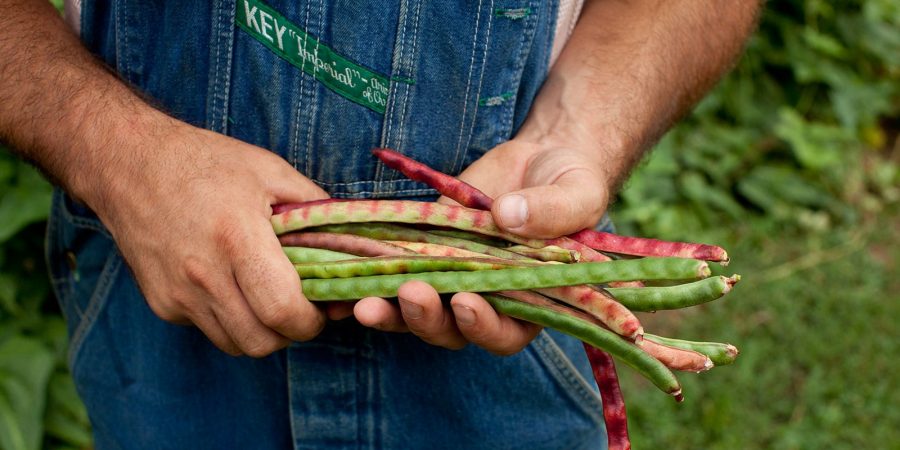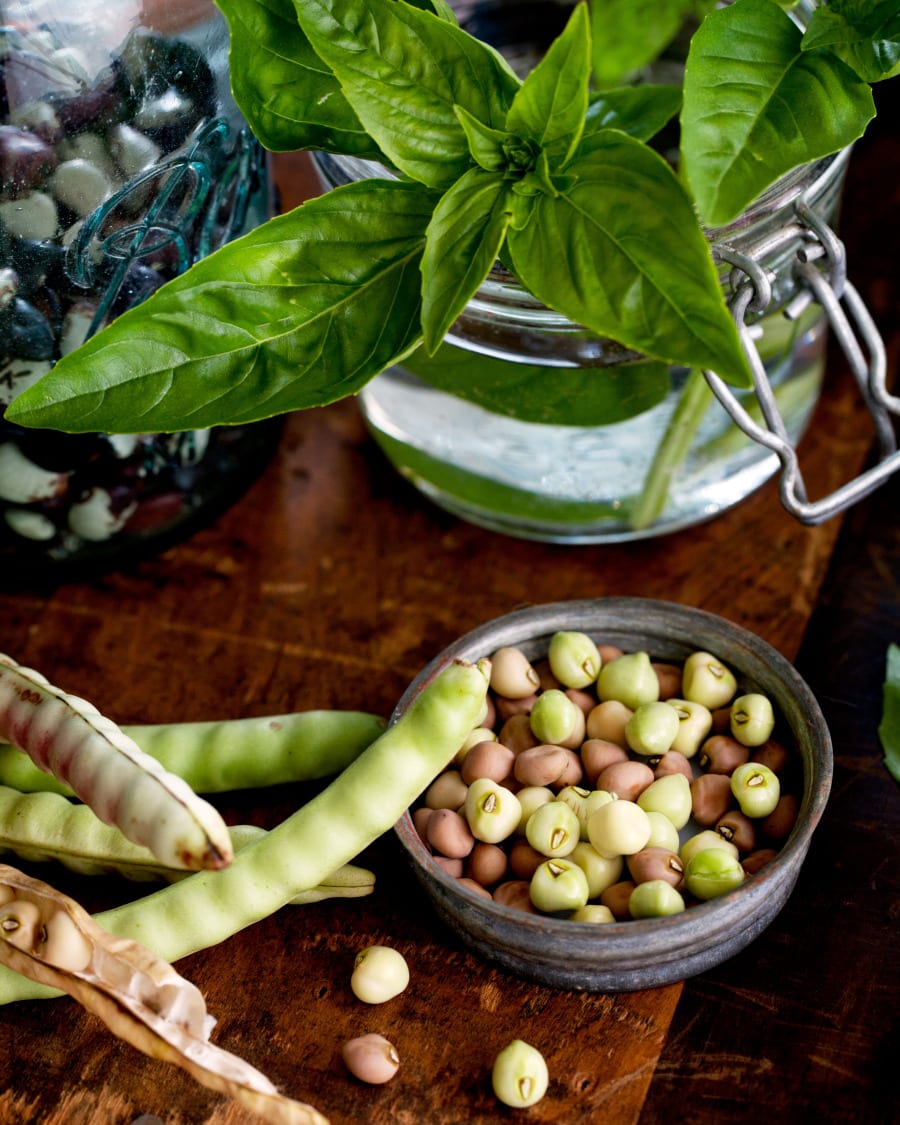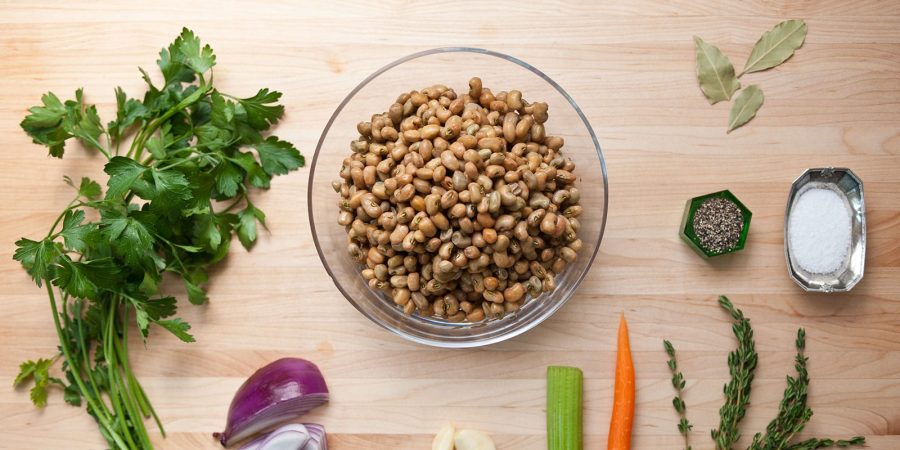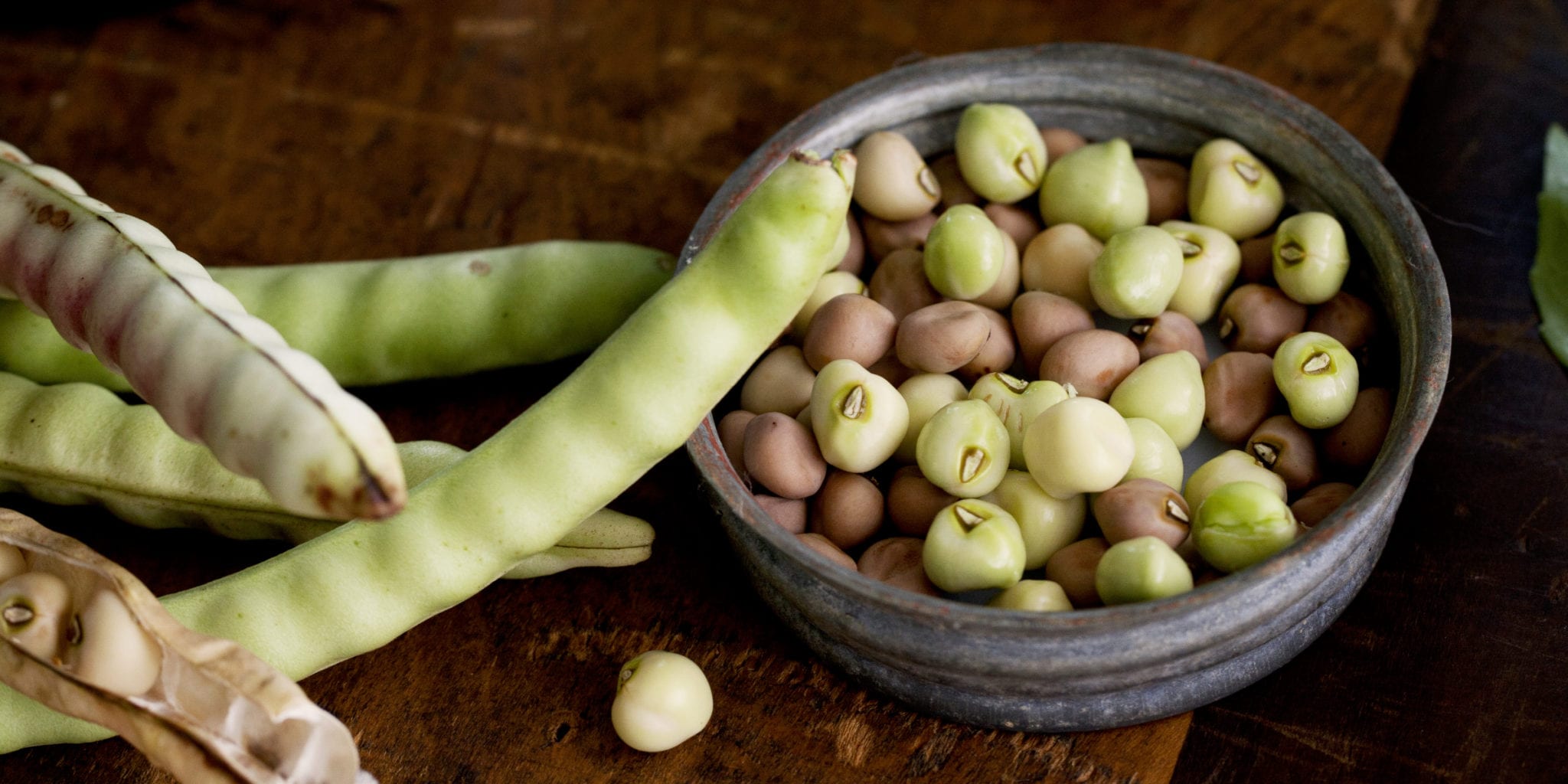Big Red Ripper, Zipper, Rucker, Stick Up, Old Timer, Turkey Craw, Whippoorwill, Purple Hull, Pinkeye, Crowder, Wash Day, Rattlesnake, Iron Clay, Bird, Cow, Colossus, Hercules, Mississippi Silver, Shanty, Polecat: they may sound like aliases in a rouges gallery, but these are just some of the names for various field peas, the most Southern of legumes.
Field peas have flourished in the South for over three hundred years and summertime Southern farmers’ markets are brimming with them, and yet fresh seasonal field peas are all too rare on contemporary Southern tables and practically unheard of elsewhere. Folks might not know what they’re missing.
The term field pea reveals its original role in the South, where for generations field peas were grown in the rice and corn fields to add valuable nitrogen back into the soil. Field peas were so common and plentiful that there was no need to tend them in a kitchen garden.
The plants are undaunted by hot, dry, poor soil that would wither many other crops. Given their critical role as subsistence food for many poor people and livestock, some culinary historians say that field peas once thrived on poverty.
Similar to ramps, the humble peas that were once relegated to the poor worked their way up to standard home cooking and are now featured on many a fine-dining menu. Field peas: one part tenacity, one part tasty.
Enslaved Africans brought field peas from their homeland. Given those fraught origins, it’s hard to imagine how or why eating field peas came to be associated with good luck on New Year’s Day, but they are said to represent coins, just as leafy greens represent folding money.
It is even more of a mystery why ubiquitous black-eyed peas, mostly canned at that, are the only type of field pea that many people know. Jeff Ross, head gardener at the legendary Blackberry Farm in eastern Tennessee, describes black-eyed peas as the red delicious apple of the pea world: the most popular is not the same as the best.
Southern Pea Soothsayers

Jeff, along with his colleague John Coykendall, knows field peas. Each year Jeff and John plant about a dozen varieties in the manicured rows of the Blackberry Farm garden, but they are curators of hundreds more heirloom varieties that were nearly lost to the ages.
A single germinated pea can bring an imperiled variety back from the brink. Heirloom peas are open pollinators, which means that when a plant survives, its seeds can be saved and planted the next year, resulting in even more viable seeds to perpetuate that variety.
Moreover, pea plants are selving, so multiple varieties can be planted close together and the strains will stay true to type. Field peas don’t lie.
To cajole a pea into production, Jeff and John cradle the germinated seed in a small cup of potting mix. They shuttle it in and out of their garden shed, making sure the burgeoning plant gets sufficient light and water.
John has been spotted taking the most delicate plants home at night, although no one can confirm whether he sleeps with one eye open. As the plant grows, they promote it to progressively larger pots until it can take a stand in the garden.
The comfortable, eclectic Blackberry Farm garden shed sits at the base of the garden. It is part laboratory, part archive, part classroom, and part clubhouse. Bowls and jars and crates of seeds, pods, and cobs line the shelves and dot the workbench. Strings of drying bean and pea pods dangle from the ceiling like stalactites.
A mound of pea hay might be raked up in one corner and winter squashes shaped like fat jugs loll around another. Hoes, froes, rakes, and other old-school tools sprout from a barrel. Open windows do any cooling in the summer and a stoked woodstove radiates any heat in the winter.
Nothing is random, yet nothing is self-conscious. The effect suggests that masterful gardening happens in this temperate Eden, and it does.
Jeff and John have been ardently working in field pea search and rescue for years. They look for obscure varieties in their travels, and other growers and seed savers sometimes send them a few precious, often unidentified, peas that they discovered in jars on dusty shelves, in the deep folds of old coat pockets, in faded seed envelopes, and even more peculiar places.
For example, they have a pea they came to call Turkey Craw. A hunter found a few whole peas in the craw of a wild turkey. When the peas germinated and then needed a name, the gardeners considered the source. Likewise, when they came across an unknown pea that grew best on a steep slope in their Tennessee foothills, it seemed fitting to call it a Siddlin’ Ground pea.
One of the favorites grown at Blackberry Farm is the Calico Crowder, a buff-colored pea with vibrant maroon splashes. Many lucky guests have left with a souvenir envelope of Calico Crowder seeds labeled in John’s distinctive script.
Peas in Different Pods

A single pea plant is its own family tree. During its four- to six-month life span, all stages of the peas’ lifecycle grow together at the same time, producing by the bushel. Various parts of the plant host blooms, immature pods called snaps, mature pods full of peas, and aging pods full of dried peas.
The peas are edible at each stage. Snaps can be eaten raw, macerated in vinaigrette, or gently cooked, similar to haricots vert. Freshly shelled beans from mature pods should be cooked and can also be frozen for storage to good effect. Dried beans keep for months and rebound quickly when soaked.
The outlier of the field pea world is the yard bean, sometimes called yard-long beans. Although they don’t really grow a full yard long, they do grow to a startling length. Unlike other field peas, they don’t fill out and are grown only for their tasty pods.
The peas and their pods can be lovely. Some peas are as smooth and round as pebbles. Others are chunky with flattened sides from crowding themselves into the pod. Some are like little ears. They can be solid, speckled, striped, and variegated.
A few are so florid that they look a child’s craft project from summer camp. It’s too bad that almost no field pea looks as lovely after it is cooked!
Not everyone has the temperament to sit and shell field peas for hours on end. The pods are tough and resistant. Some varieties have a sturdy string running down the side that acts as a rip cord that releases the peas. Others seem to demand the skills of a safecracker.
A mess of peas will wear out the side of a thumb, so many people turn to mechanical shellers, a godsend for busy cooks and farmers who know that shelled peas will be welcomed in the marketplace. The machines quickly crank out peas like a Gatling gun, shooting peas into a bucket and flinging spent shells out the back.
The Holy Land of Legumes

Communities, family farms, and farmers’ markets across the South often lay claim to their favorite peas, those best suited to both local growing conditions and treasured recipes.
In some places, discussing the relative merits of different ways to grow and cook peas is a point of civic pride, tantamount to debating barbecue. Each person who voices an earnest, heartfelt opinion is equally correct. Or not.
Dozens, if not hundreds, of different field pea varieties grow across the South each summer, peaking in production during the hot and steamy shank of the season. A stroll through a farmers’ market or stop at a roadside stand proves that field peas are inexpensive to buy.
A few minutes on the stove prove that fresh peas are easy to cook and even easier to eat. Freshly cooked peas are as superior to their canned cohorts as any other vegetable.
Anyone who thinks that black-eyed peas are the only option just isn’t looking. Anyone who thinks that bland, beige, and mushy canned black-eyed peas tell the whole story lacks inspiration. Anyone who settles for one obligatory bite of subpar peas on only the first day of the year lacks gumption.
We Southerners live in the land of fresh field peas. Lucky is as lucky does.
Crispy Spiced Field Peas
Marinated Field Pea Relish
share
trending content
-
6 Things to Do Beyond Golf in Pinehurst
by TLP's Partners -
Charlottesville, Virginia Named Wine Region of the Year
-
A New Home for Lazy Betty
by Lia Picard -
Will Travel for Southern Food
by TLP Editors -
In the Spirit: Never Say Die Bourbon
by Amber Chase
More From At the Table
-
High Tea, Southern Style
-
10 Leftover Recipes To Clean Out Your Fridge
-
Country Captain Shrimp and Grits
-
10 Nonalcoholic Drinks for Dry January
-
Our Most Popular Recipes of 2023






Comments 2
Great article
Very informative. But I can not find a source. That will let me know witch verity is climbing up or bush. I am wanting to plant both. But I need to know. Vining or bush?